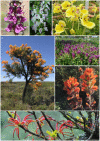The bright side of parasitic plants: what are they good for? - PubMed (original) (raw)
Review
The bright side of parasitic plants: what are they good for?
Jakub Těšitel et al. Plant Physiol. 2021.
Abstract
Parasitic plants are mostly viewed as pests. This is caused by several species causing serious damage to agriculture and forestry. There is however much more to parasitic plants than presumed weeds. Many parasitic plans exert even positive effects on natural ecosystems and human society, which we review in this paper. Plant parasitism generally reduces the growth and fitness of the hosts. The network created by a parasitic plant attached to multiple host plant individuals may however trigger transferring systemic signals among these. Parasitic plants have repeatedly been documented to play the role of keystone species in the ecosystems. Harmful effects on community dominants, including invasive species, may facilitate species coexistence and thus increase biodiversity. Many parasitic plants enhance nutrient cycling and provide resources to other organisms like herbivores or pollinators, which contributes to facilitation cascades in the ecosystems. There is also a long tradition of human use of parasitic plants for medicinal and cultural purposes worldwide. Few species provide edible fruits. Several parasitic plants are even cultivated by agriculture/forestry for efficient harvesting of their products. Horticultural use of some parasitic plant species has also been considered. While providing multiple benefits, parasitic plants should always be used with care. In particular, parasitic plant species should not be cultivated outside their native geographical range to avoid the risk of their uncontrolled spread and the resulting damage to ecosystems.
© American Society of Plant Biologists 2020. All rights reserved. For permissions, please email: journals.permissions@oup.com.
Figures
Figure 1
Illustration of functional roles of most significant parasitic plant groups (mistletoes and root hemiparasites) in ecosystems. A, Competitive alien invasive species and native invaders thriving in the absence of parasitic plants. B, Change in the plant community, increasing biodiversity. C, Diversified food supply for herbivores. D, Increased diversity and abundance of pollinators (e.g. Hymenoptera, Lepidoptera, Diptera). E, Root hemiparasite as ecosystem engineer and food opportunity for pollinators and herbivores. F, Sward gap for seedlings establishment. G, Increased soil organic matter and edafauna (Collembola, microorganisms). H, Increased food opportunity for seed herbivores and predators, seed dispersion by herbivores. I, Increased nutrient-rich litter, decompositors, and other animals living in litter. J, Mistletoe – opportunity for nesting, food, shelter.
Figure 2
Representative taxa, active compounds, and pharmacological activities of medicinal parasitic plants. A, representative parasitic plant taxa used in various continents. B, primary phytochemical ingredients reported in medicinal parasitic plants. C, medicinal activities reported for parasitic plants.
Figure 3
Cultivation of parasitic plants with high economic values promotes ecological services. A–B, A sandalwood (S. album) resort area in southern China, photos by Guohua Ma. C, Reforestation using Malania oleifera in karst regions of southwestern China. D, Grassland restoration using Rhinanthus alectorolophus in Czech Republic, photo by Stanislav Hejduk. E, Desert revegetation with root holoparasitic Cistanche tubulosa and its host Tamarix chinensis in northwestern China, photo by Pengfei Tu. F, Desert revegetation with root holoparasitic Cistanche deserticola and its host Haloxylon ammodendron in northeastern China, photo by Pengfei Tu. G, Santalum acuminatum in fruit in Southern Australia, photo by Richard McLellan
Figure 4
High aesthetic values of parasitic plants, which are used or are suitable for use in horticulture. A–C, Himalayan Pedicularis species (P. olivcriana, P. oxycarpa, and P. tricolor from left to right). D, Nuytsia floribunda, photo by Owen Roberts. E, Melampyrum arvense. Photo by Jakub Těšitel. F, Castilleja latifolia, photo by Huiting Zhang. G, Taxillus delavayi, photo by Yang Niu
Similar articles
- Impacts of parasitic plants on natural communities.
Press MC, Phoenix GK. Press MC, et al. New Phytol. 2005 Jun;166(3):737-51. doi: 10.1111/j.1469-8137.2005.01358.x. New Phytol. 2005. PMID: 15869638 Review. - Interactions between nurse plants and parasitic beneficiaries: A theoretical approach to indirect facilitation.
Melfo A, Callaway RM, Llambí LD. Melfo A, et al. J Theor Biol. 2020 Jun 7;494:110238. doi: 10.1016/j.jtbi.2020.110238. Epub 2020 Mar 6. J Theor Biol. 2020. PMID: 32151620 - Holoparasitic plant-host interactions and their impact on Mediterranean ecosystems.
Casadesús A, Munné-Bosch S. Casadesús A, et al. Plant Physiol. 2021 Apr 23;185(4):1325-1338. doi: 10.1093/plphys/kiab030. Plant Physiol. 2021. PMID: 35237829 Free PMC article. - Do native parasitic plants cause more damage to exotic invasive hosts than native non-invasive hosts? An implication for biocontrol.
Li J, Jin Z, Song W. Li J, et al. PLoS One. 2012;7(4):e34577. doi: 10.1371/journal.pone.0034577. Epub 2012 Apr 6. PLoS One. 2012. PMID: 22493703 Free PMC article. - Parasites on parasites: hyper-, epi-, and autoparasitism among flowering plants.
Krasylenko Y, Těšitel J, Ceccantini G, Oliveira-da-Silva M, Dvořák V, Steele D, Sosnovsky Y, Piwowarczyk R, Watson DM, Teixeira-Costa L. Krasylenko Y, et al. Am J Bot. 2021 Jan;108(1):8-21. doi: 10.1002/ajb2.1590. Epub 2021 Jan 5. Am J Bot. 2021. PMID: 33403666 Review.
Cited by
- Distinguishing carbon gains from photosynthesis and heterotrophy in C3-hemiparasite-C3-host pairs.
Giesemann P, Gebauer G. Giesemann P, et al. Ann Bot. 2022 May 12;129(6):647-656. doi: 10.1093/aob/mcab153. Ann Bot. 2022. PMID: 34928345 Free PMC article. - Host Resistance to Parasitic Plants-Current Knowledge and Future Perspectives.
Albanova IA, Zagorchev LI, Teofanova DR, Odjakova MK, Kutueva LI, Ashapkin VV. Albanova IA, et al. Plants (Basel). 2023 Mar 25;12(7):1447. doi: 10.3390/plants12071447. Plants (Basel). 2023. PMID: 37050073 Free PMC article. Review. - The native stem holoparasitic Cuscuta japonica suppresses the invasive plant Ambrosia trifida and related mechanisms in different light conditions in northeast China.
Wang WB, Gao FF, Feng WW, Wu QY, Feng YL. Wang WB, et al. Front Plant Sci. 2022 Sep 23;13:904326. doi: 10.3389/fpls.2022.904326. eCollection 2022. Front Plant Sci. 2022. PMID: 36212307 Free PMC article. - The Angiosperm Stem Hemiparasitic Genus Cassytha (Lauraceae) and Its Host Interactions: A Review.
Zhang H, Florentine S, Tennakoon KU. Zhang H, et al. Front Plant Sci. 2022 Jun 6;13:864110. doi: 10.3389/fpls.2022.864110. eCollection 2022. Front Plant Sci. 2022. PMID: 35734256 Free PMC article. Review. - Unlocking the hepatoprotective potential of the parasitic plant Orobanche foetida Poir. aqueous extract against CCl4-induced liver injury in rat.
Bedoui A, Mufti A, Feriani A, Baccari H, Bouallegue A, Kharrat M, Sobeh M, Amri M, Abbes Z. Bedoui A, et al. Front Pharmacol. 2024 Jan 4;14:1320062. doi: 10.3389/fphar.2023.1320062. eCollection 2023. Front Pharmacol. 2024. PMID: 38239200 Free PMC article.
References
- Alonso-Castro AJ, Juarez-Vazquez Mdel C, Dominguez F, Gonzalez-Sanche z I, Estrada Castillon E, Lopez-Toledo G, Chavez M, Cerbon MA, Garcia-Carranca A (2012) The antitumoral effect of the American mistletoe Phoradendron serotinum (Raf.) M.C. Johnst. (Viscaceae) is associated with the release of immunity-related cytokines. J Ethnopharmacol 142:857–864 - PubMed
- Ameloot E, Verheyen K, Hermy M (2005) Meta-analysis of standing crop reduction by Rhinanthus spp. and its effect on vegetation structure. Folia Geobot 40:289–310
- Arctander S (1960) Sandalwood oil East India. In S Arctander, ed, Perfume and Flavor Materials of Natural Origin. S Arctander, Elizabeth, NJ, pp 574–576
- Arunkumar AN, Dhyani A, Joshi G (2019) Santalum album. The IUCN Red List of Threatened Species 2019: e.T31852A2807668. http://dx.doi.org/10.2305/IUCN.UK.2019-1.RLTS.T31852A2807668.en (May 20, 2020)
- Bao G, Suetsugu K, Wang H, Yao X, Liu L, Ou J, Li C (2015) Effects of the hemiparasitic plant Pedicularis kansuensis on plant community structure in a degraded grassland. Ecol Res 30:507–515
Publication types
MeSH terms
LinkOut - more resources
Full Text Sources



